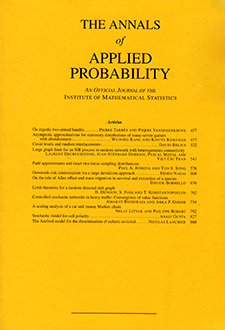Abstract
The goal of cancer genome sequencing projects is to determine the genetic alterations that cause common cancers. Many malignancies arise during the clonal expansion of a benign tumor which motivates the study of recurrent selective sweeps in an exponentially growing population. To better understand this process, Beerenwinkel et al. [PLoS Comput. Biol. 3 (2007) 2239–2246] consider a Wright–Fisher model in which cells from an exponentially growing population accumulate advantageous mutations. Simulations show a traveling wave in which the time of the first k-fold mutant, Tk, is approximately linear in k and heuristics are used to obtain formulas for ETk. Here, we consider the analogous problem for the Moran model and prove that as the mutation rate μ → 0, Tk ∼ ck log(1 / μ), where the ck can be computed explicitly. In addition, we derive a limiting result on a log scale for the size of Xk(t) = the number of cells with k mutations at time t.
Citation
Rick Durrett. John Mayberry. "Traveling waves of selective sweeps." Ann. Appl. Probab. 21 (2) 699 - 744, April 2011. https://doi.org/10.1214/10-AAP721
Information





